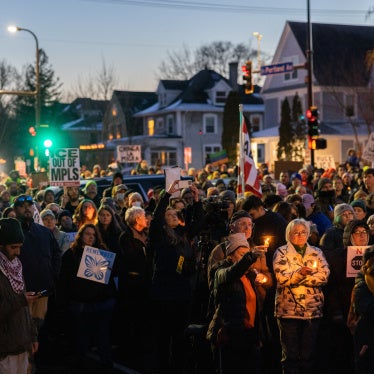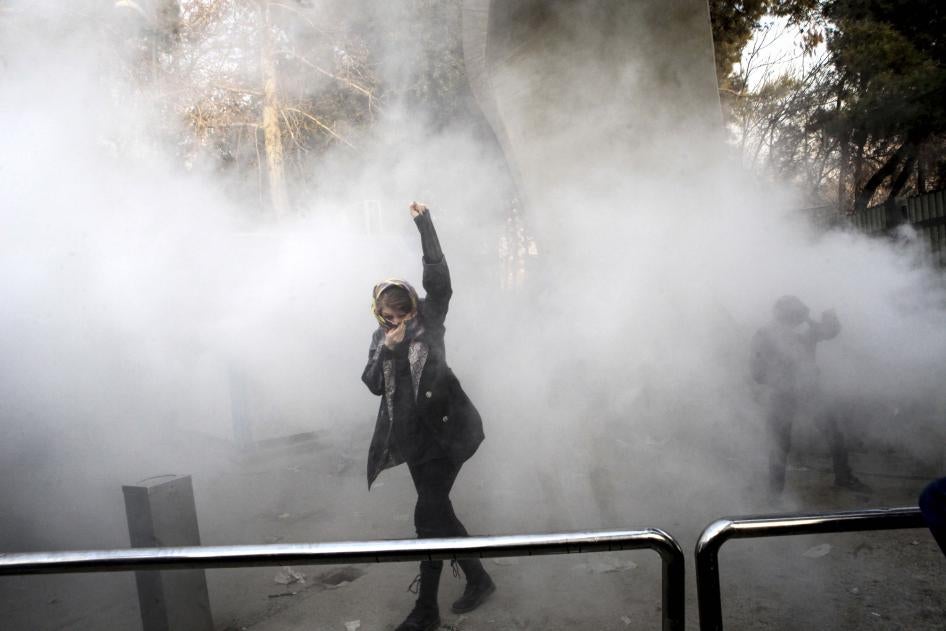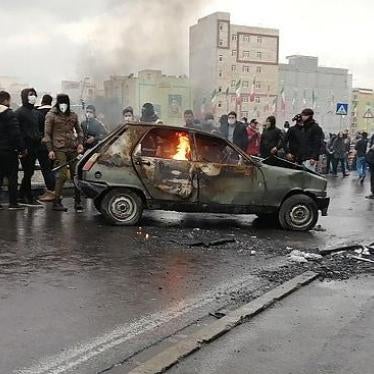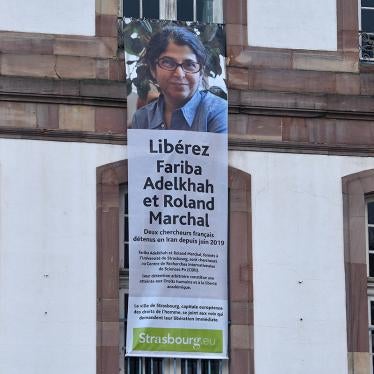(Beirut) – Iranian authorities executed a man convicted of killing a security officer during protests in December 2017 and January 2018 in Isfahan, Human Rights Watch said today. At least five other people have been arrested for alleged acts of destruction of public property in Isfahan province during the same time and are on death row despite serious due process flaws in their judicial proceedings.
On August 5, 2020, Mizannews, the judiciary’s news agency, announced the execution of Mostafa Salehi, who was convicted of shooting Sajjad Shahsanaei, a member of Iran’s Islamic Revolutionary Guard Corps (IRGC), during protests in Kahrizsang, a small town in Isfahan Province, on January 1, 2018. The Islamic Republic of Iran Broadcasting agency (IRIB) said that witnesses had reconstructed the scene of the shooting in the presence of the accused, but there has been little information about whether Salehi had access to legal counsel and was tried under fair legal standards.
“Iranian authorities execute people without due process while failing to investigate serious allegations of authorities’ excessive use of force against protestors,” said Tara Sepehri Far, Iran researcher at Human Rights Watch. “Iran should immediately halt all executions, grant the accused a fair and transparent judicial process, and prioritize a comprehensive investigation into the killings of hundreds of protesters over the past two years.”
The Iranian judicial system has a record of deeply flawed trials, depriving those accused of national security crimes of fair proceedings and trial. A Human Rights Watch review of the verdicts for five other people on death row in Isfahan showed that their trials were marred by similar violations.
On September 26, 2018, Mohammadreza Tavakoli, the Najafabad county prosecutor, told reporters that security forces had arrested the person responsible for killing Shahsanaei. He said that the accused has not confessed to the alleged crime and claimed, without providing any evidence, that the accused had contacts with foreign intelligence. IRIB news agency reported that the trial opened at Branch 1 of Isfahan’s criminal court on February 17, 2019.
In a separate case from the protests during December 2017 and January 2018 in Isfahan province, Branch 2 of Isfahan’s revolutionary court tried 13 people for their alleged roles in protests in the city of Khomeini Shahr, and then sentenced 5 of them to death. Branch 19 of Iran’s supreme court upheld these sentences on May 13, 2020, in a verdict reviewed by Human Rights Watch. The revolutionary court had brought 14 charges against the defendants, including 8 accounts of vaguely defined national security charges such as “corruption on earth,” moharebeh (enmity against God), and baghi (armed rebellion) through the use of firearms.
The prosecutor accused the defendants of destroying public property including setting a bank on fire. The defendants appear to be acquaintances of Asghar Haroon al-Rashidi, a man killed by a bullet during the protests in Khomeini Shahr.
The court sentenced Mehdi Salehi, Mohammad Bastami, Majid Nazari, Hadi Kiani, and Abbas Mohammadi to death on charges of armed rebellion and enmity against God through the use of firearms, and to five years in prison on the charge of corruption on earth through disrupting public and private security. The court sentenced the other eight defendants to imprisonment and flogging.
The verdict, which includes several statements by defendants incriminating each other, fails to ultimately attribute responsibility for the commission of a specific crime to each defendant individually.
Security forces have responded to widespread protests over the past three years with excessive use of force and mass arrests of protesters, and they have failed to conduct any transparent investigations into protesters’ deaths. The former spokesperson for the judiciary said that 25 people were killed during the protests in December 2017 and January 2018.
In the most recent example, the authorities used excessive and unlawful lethal force in confronting large-scale protests that began on November 15, 2019. According to Amnesty International, at least 304 people were killed during the protests. On June 1, Mojtaba Zonoor, the head of Iran’s parliamentary national security committee, said that 230 people had been killed during the protests. The authorities have not published any detailed investigation or held anyone accountable for their alleged abuses.
In February 2020, Branch 15 of Tehran’s revolutionary court also sentenced to death Amirhossein Moradi, Saeed Tamjidi, and Mohammad Rajabi, three young men who were arrested after participating in the November 2019 protests, on charges of “taking part in destruction and burning, aimed at countering the Islamic Republic of Iran.” In July, the Supreme Court upheld their sentences, while lawyers had difficulty accessing the court documents and their defendants. On July 10, lawyers representing the three announced that the judiciary had halted their executions and accepted their pleas for a new trial.
Human Rights Watch opposes the death penalty in all circumstances because it is inherently cruel and irreversible.
Under international human rights law, everyone has the right to freedom of expression and peaceful assembly as provided under the International Covenant on Civil and Political Rights (ICCPR), to which Iran is a party.
International law guarantees anyone accused of a crime access to a lawyer at all stages of criminal proceedings, including during the investigation, the pretrial proceedings, and during the trial itself. Under Article 1 of the United Nations basic principles on the role of a lawyer, “All persons are entitled to call upon the assistance of a lawyer of their choice to protect and establish their rights and to defend them in all stages of criminal proceedings.”
Under the United Nations Basic Principles on the Use of Force and Firearms by Law Enforcement Officials, law enforcement officers may use force only when strictly necessary and to the extent required to achieve a legitimate policing objective. When using force, law enforcement officers should minimize damage and injury and respect and preserve human life. The deliberate use of lethal force is permissible only when it is strictly necessary to protect life.
“International actors, including the European Union, should pressure Iran to stop these executions immediately and instead open a comprehensive inquiry into the killing of hundreds during these protests,” Sepehri Far said.
|
News Release
Iran: Protester Accused of Killing Soldier Executed
Lack of Due Process, Prisoners on Death Row
Your tax deductible gift can help stop human rights violations and save lives around the world.
Region / Country
Most Viewed
-
March 29, 2021
“Everything I Have to Do is Tied to a Man”

-
November 25, 2019
A Dirty Investment

-
January 9, 2026
Canada: Confront China’s Heightened Repression

-
January 8, 2026
Iran: Authorities’ Renewed Cycle of Protest Bloodshed

-
January 9, 2026
US: Minneapolis Killing by ICE Unjustified





